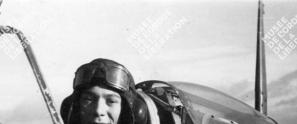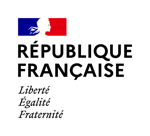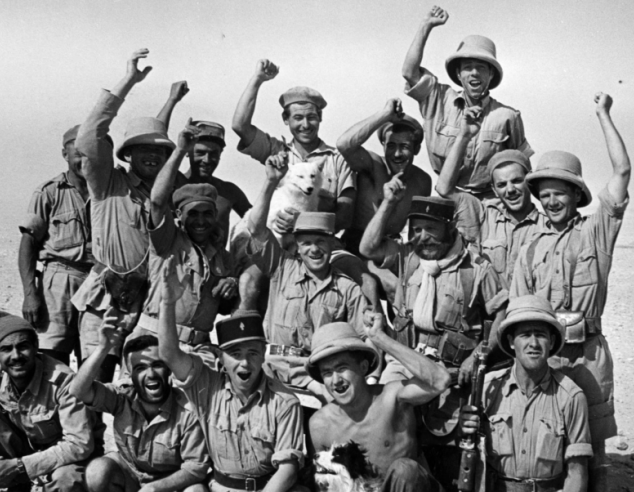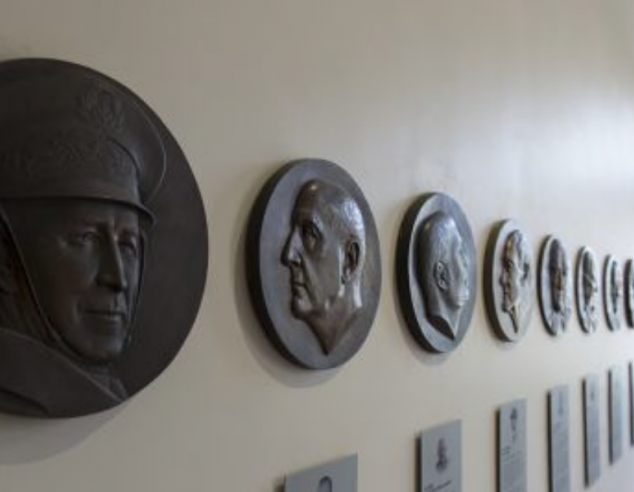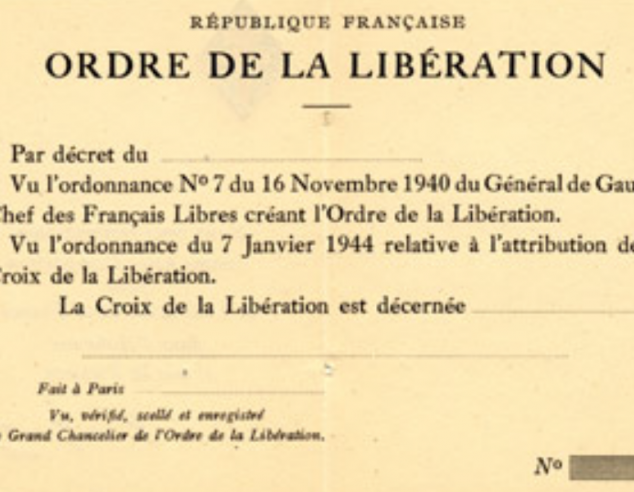French Air force
Free France's air arm – the Free French Air Forces (FAFL) – was officially created on 1 July 1940. But its structured units, which each bore the name of a French province, did not truly emerge until the summer of 1941. Six of them bear the title of Companion of the Liberation.
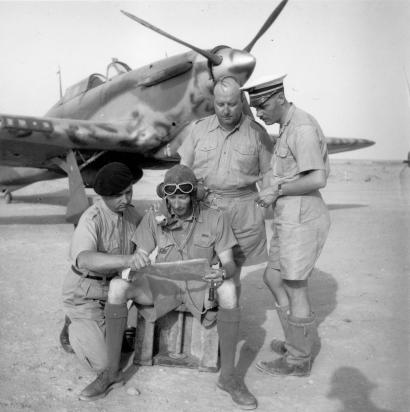
In late 1940, it was decided that Free French fighter pilots stationed in French Equatorial Africa would be sent to Egypt to form a French flight, or escadrille in French, following an agreement between General de Gaulle and the British Air Ministry. Six pilots among the first to volunteer for Free France were appointed (James Denis, Louis Ferrant, Albert Littolff, Robert Guédon, Noël Castelain and Xavier de Scitivaux) and arrived in Cairo at the end of February 1941 before being sent to Ismailia, where they continued their training which had been disrupted for several months.
On March 15, 1941 under the command of Lieutenant James Denis, they were immediately posted to 33 Squadron of the Royal Air Force in Greece. Equipped with Hurricanes, they were tasked with defending Athens. However, due to diplomatic reasons (French officials on the ground were accredited by the Vichy government), the pilots were swiftly sent back to Africa. In early April, the pilots headed back to Alexandria then Tobruk, where Escadrille française de chasse n° 1 (EFC 1) was created on April 9.
On April 10, EFC 1 took part in defending Tobruk, besieged by the Italians and Germans, within 73 Squadron with which it formed Flight C. Up until April 14, its missions solely consisted of attacking motorized Italian/German troops before it engaged in aerial combat for the first time.
From April 14-25, these Free French fighter pilots clashed with enemy planes and were outnumbered one to ten at best. They completed 81 missions and achieved 10 official and 2 probable aerial victories with minimal losses (Staff Sgt Guédon was declared missing in action and Staff Sgt Castelain was injured). In the meantime, the flight received reinforcements in the form of Chief Warrant Officer Ballatore. The flight fell back to Sidi-Hanish where it was joined by Second-Lieutenant Pompéi followed by Warrant Officer Guillou, and dedicated its efforts to ground attacks and protecting convoys at sea. On May 31, Warrant Officer Guillou was shot down in combat while flying over Crete.
On June 21, 1941, Escadrille française de chasse n° 1 was awarded the Cross of Liberation, becoming the first military unit to receive this prestigious decoration. Surveillance missions followed despite a growing lack of airworthy aircraft, which, much to the dismay of the pilots and mechanics, put the flight out of action.
The end of the Syrian campaign and the arrival of Colonel Martial Valin in the Middle East made it possible to create more substantial fighter units. In late August 1941, EFC 1 set off for Lebanon, where it was soon disbanded and replaced in early September by fighter group Groupe de chasse n°1 Alsace, formed in the Bekaa Valley, marking the start of a new chapter.
Out of 165 missions, EFC 1 amassed 17 aerial victories and destroyed numerous ground vehicles. Nine of its pilots were named individual Companions of the Liberation.
On October 18, 2019, the Minister of the Armed Forces, Florence Parly, formally presented the Escadrille française de chasse n° 1 pennant to first-year students of the Ecole de l’Air, marking the revival of EFC 1 within the French Armed Forces. As a result, first-year officer cadets will wear the Order of the Liberation fourragère for one year.
- Companion of the Liberation - Decree of June 21, 1941
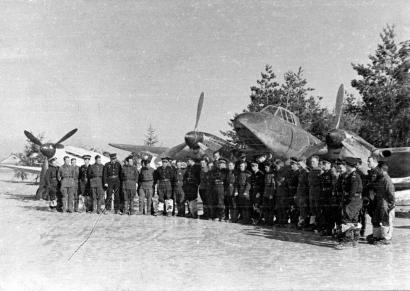
General de Gaulle planned to send French soldiers to the Eastern Front as soon as Germany invaded the USSR in June 1941. Fifteen months later in September 1942, a third fighter unit from the Free French Air Forces was established (following the formation of the Alsace and Ile-de-France groups one year earlier): Groupe de chasse n° 3 Normandie. Set up in Damascus under the orders of Commander Pouliquen and Commander Tulasne, the group was swiftly informed that it had been selected to mark the presence of France alongside the Soviets on the Eastern Front.
In November 1942, the first pilots and mechanics set off from Lebanon to the Soviet Union on a journey that lasted over two weeks. The first base was at Ivanovo, 250 km north-east of Moscow. Once there, the French picked up Russian planes and started training on two-seater Yak-7 planes and single-seater Yak-1 planes. The decision was made by the French commander to opt for Yak-1 planes.
Weather conditions were very harsh and hard to handle, with temperatures varying between -77°F and -86°F. The 58 French pilots and mechanics continued their training up until March 1943. On March 22, 1943, the unit flew a hundred or so kilometers to the south-west of Moscow in 14 Yaks, settling at a base in Polotnyany Zavod. Thawing ice made take-offs and landings very dangerous, especially since the runways were often just fields; three men were needed beneath each wing to push planes onto the runway. The base at Polotnyany Zavod was situated around 50 km away from the front.
Aircraft operated very close to the front lines to achieve greater efficiency in the absence of all forms of radio control. French pilots tasked with escorting Russian bombers soon began to rack up successes. On April 5, Préciozi and Durand each shot down a Focke-Wulfe 190. The unit secured three more victories on April 13. It continued to return victorious from its missions, but also lost several pilots from the Normandie group.
During July 1943, the flight entered into the heat of the action at the terrible Battle of Kursk. Missions continued without disruption. From July 13-17, Normandie carried out 112 sorties and shot down 17 German aircraft. These victories were hard-won, resulting in the loss of six pilots including Commander Tulasne, who was declared missing in action near Orel on July 17.
Commander Pouyade, who had joined the unit the previous month, took command. In early August, French mechanics were replaced by Russian mechanics, and the pilots’ Yak-1 planes were replaced with Yak-9 planes. The front moved towards the west. August 22 marked the Battle of Smolensk. Creeping up on three Stukas platoons escorted by a dozen Focke-Wulf 190, the fighter group shot down five planes in a matter of seconds, without incurring any losses.
By September 1, 1943, the group had amassed a total of 42 confirmed victories. On September 22, the French pilots shot down nine enemy aircraft in seventeen sorties, with Joseph Risso achieving a fantastic double hit. By the time it headed to its winter quarters in Tula, south of Moscow, in November 1943, Normandie had already amassed 72 victories. While resting, it was covered by reinforcements led principally by Marcel Albert and Marcel Lefèvre. On February 7, 1944, the group was given a new title, unique in France: Régiment Normandie. It was composed of three flights (Rouen, Le Havre and Cherbourg) respectively commanded by lieutenants Albert, Mourier and Lefèvre.
The offensive resumed in June after a calmer period in early 1944. In less than three weeks, Soviet troops had pushed over 200 kilometers west, before crossing the Neman River. The fighting was terrible. The exemplary actions of the regiment earned it the name of “Niemen”, given by Marshal Stalin on July 21, 1944.
From that point on, the regiment became known as “Normandie-Niemen”. It went on to fight in East Prussia, before heading to its winter quarters. On December 12, 1944, Commander Delfino took command of Normandie several days after the regiment had been awarded the Cross of Liberation by General de Gaulle while on his way to Moscow. Fighting resumed for the third campaign in East Prussia and Poland, before the Germans finally surrendered on May 9, 1945. To reward the exemplary actions of French pilots on the Soviet front, Marshal Stalin donated Yak-3 planes to the surviving pilots in early June 1945. The pilots landed in Le Bourget on June 20 and received a hero's welcome from the huge crowds waiting for them.
Through the sacrifice of almost half its pilots, with 42 killed out of 97, Normandie-Niemen became the first French fighter formation to have achieved 273 confirmed victories and 37 probable victories (to which a large amount of destroyed vehicles can be added), over the course of 5,240 missions and 869 battles. 21 Companions of the Liberation feature in its ranks.
- Knight of the Legion of Honor
- Companion of the Liberation - Decree of October 11, 1943
- Military Medal
- Croix de guerre 1939-45 (6 citations)
- Order of Alexandre Nevski (USSR, ukase of June 5, 1945)
- Order of the Red Flag (USSR, ukase of February 19, 1945)
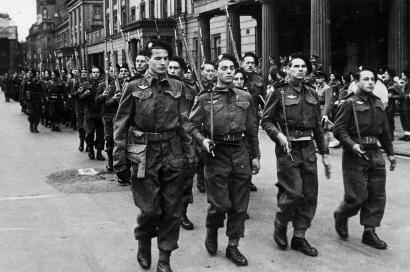
1ÈRE COMPAGNIE D'INFANTERIE DE L'AIR (1ère CIA)
Under the leadership of Captain Georges Bergé, an air infantry company, 1ère Compagnie d'infanterie de l'air, was established in England on September 29, 1940. On December 25, 1940 after extensive training, the 1st section (two officers, four non-commissioned officers, nineteen troop ranks) was brevetted at Ringway with the Royal Air Force 1st Parachute Battalion. A second section was brevetted on February 21, 1941.
While a dozen French paratroopers took part in sabotage training, the first war mission for the French paras was carried out by Captain Bergé and four men in Brittany. The mission was Operation Savannah (March 15, 1941), which had a huge impact, being the first one to take place in occupied France. On April 10, 1941, the Company transferred to the command of the French Army and became known as 1ère Compagnie parachutiste. The following month, the Joséphine B mission took place using four paratroopers and resulted in the destruction of the power station in Pessac, Gironde.
In May 1941, 1ère CIA had nine officers, nineteen non-commissioned officers and 70 troops. It was split into two parts: a section assigned to the Central Bureau of Intelligence and Operations (BCRA) for clandestine action (in other words, to the Secret Service of the Free French Forces), and two infantry sections who boarded ships for the Middle East on July 21, 1941 under the name of 1ère Compagnie parachutiste.
In September 1941, 1ère Compagnie parachutiste became known as Peloton parachutiste du Levant, before being transferred back to the French Air Force and named as 1ère Compagnie de chasseurs parachutistes des Forces aériennes françaises libres.
THE FRENCH SQUADRON
After being stationed in Beirut and Damascus, the unit moved to Kabret, on the banks of the Suez Canal on January 2, 1942. It became part of the British Special Air Service Brigade (SAS Brigade) commanded by Major Stirling. The French SAS became the French Squadron and was known for its violent attacks behind enemy lines and against German airfields, achieving very significant results: in Crete, June 1942, it destroyed around twenty German planes (Captain Bergé was captured during the operations) and in Libya (attacks on airfields in Matouba-Derna, Benina, Barce and Benghazi) during the same period. The following month, the French SAS operated in Cyrenaica under the orders of Captain Jordan, Bergé’s second-in-command and new leader.
In Tunisia in January 1943, while the British Eighth Army was advancing towards Tripoli, it was tasked with harrying the German rear. Augustin Jordan and Major Stirling were captured during the missions. The African campaign came to an end following operations in Tunisia, and survivors from 1ère CIA made their way to England.
At the same time, volunteers from all over had been gathered and trained in Camberley, England since 1941. Along with survivors from the Middle East, they formed a first air infantry battalion 1er Bataillon d'Infanterie de l'Air (1er BIA) in July 1943, commanded by Commander Pierre Fourcaud.
4E BATAILLON D'INFANTERIE DE L'AIR (4E BIA)
In November 1943, 1er BIA became the fourth air infantry battalion, 4e bataillon d'infanterie de l'air (4e BIA), and passed under the command of Commander Pierre-Louis Bourgoin. The battalion was joined in England by a third air infantry battalion, 3e bataillon d'infanterie de l'air (3e BIA), formed after the liberation of North Africa.
The 435 paratroopers began actively preparing for the landings in Scotland.
After having taken part in major maneuvers such as night jumps, the first French SAS soldiers were dropped in Brittany during the night of June 5-6, 1944. Two sticks made up of eight men each were dropped along the northern coast of France, while two others were dropped over Morbihan. Their mission was to set up a base, isolate Brittany from the rest of the country, and make contact with the French Resistance in order to define the attacks it would carry out with them. The sticks fulfilled their mission with varying degrees of difficulty and the first reinforcements of men and equipment were dropped over Brittany during the night of June 9-10, swiftly followed by all troops from 4e BIA.
The SAS and French Forces of the Interior (FFI) managed to join forces with General Patton’s army following numerous clashes and fights with the enemy, particularly in scrubland in Saint-Marcel in the Morbihan region. However, 4e BIA suffered heavy losses: 73 men were killed in fighting in Brittany.
Under the orders of Commander Château-Jobert (aka Conan), 3e BIA also took action in Brittany.
2E RÉGIMENT DE CHASSEURS PARACHUTISTES (2E RCP)
Meanwhile, 4e BIA changed its name on July 1, 1944, becoming known as 2e Régiment de chasseurs parachutistes de l'Armée de l'Air (2e RCP). Similarly, 3e BIA became 3e RCP.
In late August 1944, despite suffering heavy losses, 2e and 3e RCP were equipped with Jeeps heavily armed with Vickers machine guns and tasked with keeping the enemy away from the right bank of the Loire, so that it could be ensnared with support from Allied forces coming from Normandy and the Rhône Valley. SAS raids multiplied, and several platoons liberating towns and villages headed as far as Bordeaux and Périgueux. On September 11, a company of 2e RCP secured the surrender of 3,000 Germans and forced 15,000 more to turn back.
Following three months of solid fighting, 2e RCP was placed on rest in the fall of 1944. On November 11, 1944 under the Arc de Triomphe, General de Gaulle awarded it the Cross of Liberation with the following citation:
“An elite formation, who, under the orders of Lieutenant-Colonel Bourgoin, had the distinct honor of being the first French unit to fight once again on French soil. Dropped over Brittany over the course of June, it successfully assembled over 10,000 resistance fighters. With this support, and at the expense of many lives, it proceeded by successfully attacking enemy equipment and destroying numerous telephone networks, ammunitions depots and communication lines of vital importance to the enemy. It played a key role in the success of the Allied offensive from the Normandy bridgehead and was behind the liberation of Brittany.”
On December 30, 1944 during the Von Rundstedt Offensive, 200 men from 2e RCP, now under the orders of Commander Puech-Samson, were swiftly sent to the Belgian Ardennes. They brought back a large number of prisoners with them.
In February 1945, 2e and 3e RCP were assembled in England. During the night of April 7-8, contingents from each unit were dropped in Holland over an area stretching 2,500 km2. The aim of the operation was to create maximum confusion among the enemy and to hamper its movements. Violent clashes occurred, and the sticks would have to hold firm between eight and ten days (instead of the two to three days originally predicted) before receiving support from the Canadian Army.
On August 1, 1945, parachute units passed under the control of the Army. 3e RCP was disbanded and its men were incorporated into 2e RCP, placed under the orders of Lieutenant-Colonel de Bollardière.
In addition to the Cross of Liberation, 2e RCP’s flag displays the Croix de Guerre 39-45 with 6 palms, the Belgian Croix de Guerre, the Dutch Croix de Guerre, and the Bronze Star Medal (US). Out of the 24 Free French paratroopers that have been made Companions of the Liberation, 15 are from ranks in 2e Régiment de chasseurs parachutistes de l'Armée de l'Air.
The French Army’s marine infantry parachute regiment, 1er Régiment parachutiste d'infanterie de marine (1er RPIMa), created on November 1, 1960 and stationed in Bayonne, carries on the regimental traditions and values of 2e RCP today. As such, it is entitled to wear the fourragère in the colors of the Order of the Liberation.
- Companion of the Liberation - Decree of November 8, 1944
- Croix de guerre 39/45 (6 palms)
- Croix de guerre 40/45 (Netherlands)
- Bronze Star Medal (USA)
See all the Companions of the 2e Régiment de chasseurs parachutistes de l'Armée de l'Air.
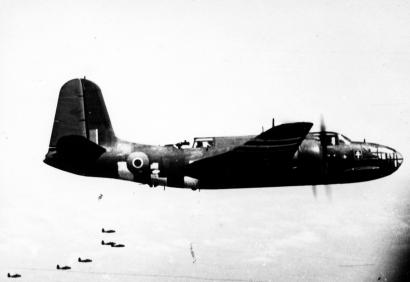
While Groupe de bombardement Lorraine, also known as No. 342 Squadron RAF, was officially formed on September 24, 1941 in Damascus, Syria, the majority of its contingency had previously fought for over a year in Gabon, Kufra and Chad. It often suffered from a lack of resources but had a fierce desire to fight on. As of November 1940, General de Larminat formed a reserve bombardment group, Groupe réservé de bombardement n° 1 (GRB 1), in Chad, placed under the command of Captain Astier de Villatte.
The group, part of which had previously helped rally the support of Gabon, swiftly provided support to Colonel Leclerc’s troops.
Missions, particularly during the Capture of Kufra in March 1941, took place in very harsh conditions with the heat, sand, and a lack of infrastructure.
From April to July 1941, GRB 1 was active in Abyssinia – where it carried out 130 missions – and Eritrea. It was stationed close to Damascus on its return and assembled with Groupe de bombardement n° 2 commanded by Captain Goussault. On September 2, 1941, the two units were disbanded to form Groupe de bombardement n° 1 Lorraine, a bombardment group made up of two flights from Metz and Nancy under the orders of Captain de Saint Péreuse, succeeded by Commander Corniglion-Molinier in October. Equipped with Blenheim bombers, the Lorraine group received technical support from the Royal Air Force.
From November to December 1941, the number of missions carried out increased significantly as it supported the British Army in its efforts over Libya, and on November 23, it destroyed a column of tanks. However, it also suffered heavy losses. In December, Lieutenant-Colonel Pijeaud came from England and took control of the group, but was fatally injured during his first mission. He was replaced by Captain Saint-Péreuse.
Since the Afrika Korps had been brought to a halt, the Lorraine group supported the Allied offensive. In the space of 16 days in January 1942, the group carried out 300 sorties before heading to the Levant; a third of its flying personnel had either been killed or injured.
In Syria, the group was divided into two self-sustaining flights, with one (Nancy) stationed in Damascus, and the other (Metz) in Rayack, Lebanon. Both units were tasked with transporting aircraft and carrying out coastal surveillance. During one of the missions, a plane from Nancy flight damaged a German submarine. In October 1942, Lorraine group boarded ships at Suez and headed back to Great Britain to serve on the Western front.
After arriving at Greenock on January 1, 1943, all of the group’s personnel were sent on training before Lorraine was reorganized at West Raynham on April 7, 1943. Under the orders of Commander de Rancourt, it became No. 342 Squadron of the Royal Air Force within 137 Wing, and, equipped with Douglas Boston IIIs, took part in bombing missions day and night, at medium and very low altitudes.
Missions took place over France and Holland and varied greatly: power stations, railway yards, airfields, V-1 sites, etc. On October 3, 1943, the group, newly based at Hartford Bridge in Hampshire, bombed and destroyed 90% of the Chevilly-Larue transformer station to the south of Paris, which supplied power to the Paris region. Placed under the orders of Commander Michel Fourquet in December 1943, Lorraine group began specializing in night bombing raids in spring 1944.
At 6 am on June 6, 1944, it created a smokescreen along the coastline, designed to protect the Allied fleet from German bombs at low altitudes (50 feet!), as part of the Normandy landings. The mission was a complete success. Operations over Normandy followed in very difficult and deadly conditions, such as the low-altitude (50 meters) night attack against German armored divisions surrounded in the Falaise pocket on August 5, 1944. Lorraine lost 5 crews in the first week of August.
On October 17, 1944, aircraft landed in Vitry-en-Artois, France, the location of its new base. Shortly after, Lorraine passed under the command of Jacques Soufflet. After the front was breached, the group took part in all operations marking Marshal Montgomery’s advance: the Battle of Ardennes, crossing of the Rhine, Arnhem, destruction of the bridges over the Rhine, etc. Newly equipped with American B-25 Mitchell bombers and positioned in Gilzerijzen, Holland, it carried out its last war mission on May 2, 1945. It received the Cross of Liberation on May 28, 1945. It lost 127 of its crew members, representing more than double its normal numbers. During the war, it dropped over 2,500 tons of bombs during more than 3,000 sorties. On June 10, 1945, it flew with 3,000 Allied planes over Frankfurt. Eight days later, it flew over the Champs-Élysées in a formation representing its symbol: the Cross of Lorraine.
54 Groupe de bombardement Lorraine personnel have been named Companions of the Liberation. Today, fighter squadron 03/030 Lorraine is stationed at Mont-de-Marsan.
- Companion of the Liberation - Decree of May 28, 1945
- Croix de Guerre 39-45 (7 citations)
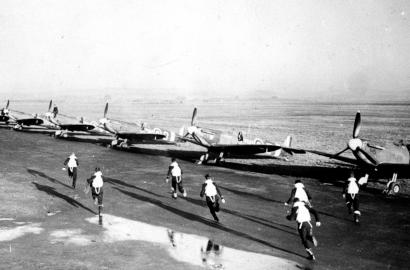
On October 20, 1941, General de Gaulle, who planned to create a French fighter group in England, signed a decree establishing the creation of the first group incorporated into the Royal Air Force (RAF), named 340 Squadron. Its personnel included pilots and mechanics from the Free French Air Forces (FAFL) and the Free French Naval Forces (FNFL)
In November 1941, the “sea and air” fighter group was created in the grounds of Turnhouse, Scotland within No. 13 Group, part of Fighter Command. Following Valin’s decision to attribute the names of French provinces to FAFL airborne units, 340 (Free French) Squadron, also known as Groupe de chasse n° 2 was named “Ile-de-France”. Comprising two flights, named “Paris” and “Versailles” respectively, it was passed under the orders of a British officer, Squadron Leader Loft.
While it was relatively easy to gather French pilots, this was not the case for mechanics, half of which were also English. The others came from the French Air Force, particularly from Naval aviation, who provided a strong contingent of Tahitians. Among the very first pilots assigned to Ile-de-France were Captain Dupérier, Lieutenant-Commander de Scitivaux and Lieutenant Mouchotte, already enlisted in 615 Squadron, and Second-Lieutenant Schloesing in 132 Squadron. The pilots were equipped with Spitfire Mk. II fighters, divided into two flights with 12 aircraft each.
On January 31, 1942, Lieutenant-Commander de Scitivaux was put in control of the group. Captain Dupérier finalized the “Cross of Lorraine” formation, which was presented to General de Gaulle during his trip to Turnhouse on February 12. Alternating between combat training and watch periods, 340 Squadron was equipped with Spitfire Mk V fighters, loaded with two 20 mm canons and four 7.7 mm machine guns.
On March 31, the group was transferred to Redhill, a base to the south of London, within No. 11 Group. However, a week later it moved to Westhampnett, a satellite base at RAF Tangmere. It was assigned to Tangmere Wing commanded by Wing commander M.L. Robinson. On April 10, 1942 the first war mission took place at great cost: Wing Commander Robinson and Lieutenant Choron were killed. De Scitivaux was shot down and taken prisoner. He was replaced by Captain Dupérier.
On May 8, three FW 190s were shot down, kicking off the group’s fantastic record. Promotions and citations rewarded 340 Squadron’s fighting spirit. From July 1942, the group operated out of the grounds of Hornchurch. On August 19, 1942, it took part in the Allied air umbrella over the landing area in Dieppe (Operation Jubilee). Over the course of a day where many lives were lost, 340 Squadron shot down four enemies but lost a pilot and two aircraft.
On September 22, 1942, the group was transferred to a base at Biggin Hill and received its Spitfire Mk IX fighters. Commander Dupérier was replaced by Captain Schloesing on November 30, after largely completing his tour of duty. Schloesing was shot down on February 13, 1943. He was badly burned, but still managed to reach England.
In December 1942, the marines left Ile-de-France, making it an exclusively “airborne” unit. Captain Reilhac, who took over from Schloesing, was also declared missing in action during operations on March 14, 1943. He was replaced by Captain Jean Fournier, who was then immediately promoted to Captain, and led the squadron to Turnhouse several days later for a period of rest. The group left its Spitfire Mk IX fighters with its replacement, fighter group GC Alsace, and was deployed to Drem where it provided cover for the Glasgow-Edinburgh area.
On November 10, 1943, 340 Squadron Ile-de-France and 341 Squadron Alsace assembled at Perramporth to form 145th Wing, commanded by Commander Dupérier. The war missions that followed were in line with the general’s plan for landing preparations, which aimed to weaken the enemy’s fighting potential by harrying and destroying its lines of communication, fixed defenses and port facilities.
By February 1944, the squadron was once again equipped with Spitfire Mk IX fighters and in March, 145th Wing was incorporated into the Allied Expeditionary Air Forces within 84th Group in the 2nd Tactical Air Force. Deployed to Merston, the Ile-de-France group tirelessly carried out escort missions and attacked V-1 launch sites and communication lines.
Right before the landings, black and white “invasion stripes” were painted onto the wings and fuselages of the Spitfires. The group took part in the Allied air umbrella over the landing area along the Normandy coastline as the sun rose on June 6, 1944. On June 13, the group’s aircraft finally touched down on French soil in Sainte-Croix. On August 19, Ile-de-France moved to Sommervieu, near Bayeux. Allied forces had gained control of the skies, which saw 340 Squadron’s missions focus on supporting Allied troops in Belgium and Holland.
On November 2, 1944, the group was placed under the command of Commander Olivier Massart; relieved of its duties, it was repatriated to Biggin Hill, then to Drem. In February 1945, it was re-equipped with Spitfire Mk XVI fighters and returned to the front at Schinjdel, Holland, accompanied by 329 Squadron and 345 Squadron. It was tasked with prohibiting all enemy traffic from passing between the Meuse and Rhine rivers. On March 13, 1945, Olivier Massart was shot down in aerial combat. On April 17, the group reached its new base in Drope, Germany under the orders of Commander Pierre Aubertin. It carried out its final war mission on May 3.
In four years, 340 Squadron carried out 7,100 sorties, destroying and damaging 75 enemy aircraft, and dropped 400 tons of bombs. Ile-de-France, who lost 38 pilots, received the Military Medal and was awarded the Cross of Liberation. It was cited four times by the French Air Force and once by the Free French Air Forces. 22 Companions of the Liberation feature among its ranks.
- Companion of the Liberation - Decree of May 28, 1945
- Military Medal
- Croix de Guerre 39/45 (5 citations)
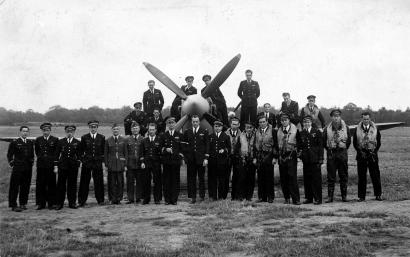
The French flight Escadrille française de chasse n° 1 (EFC 1) was formed in Ismailia, Egypt on March 15, 1941, less than one year after the Armistice took place. Its pilots were among the first to volunteer for Free France. The flight came under the command of Lieutenant James Denis. Equipped with Hurricane fighter planes, EFC 1 took part in defending the besieged city of Tobruk within 73 Squadron, with which it formed Flight C.
From April 9-25, the Free French soldiers clashed with enemy aircraft and held their ground despite being outnumbered one to ten. They racked up 10 aerial victories and 2 possible victories in less than two months.
Following the Allied retreat, the flight, based at Sidi-Hanish, was mainly tasked with ground attacks and protecting convoys at sea.
On June 21, 1941, Escadrille française de chasse n° 1 received the Cross of Liberation, becoming the first military unit to hold the prestigious decoration. On August 28, EFC 1 headed for Lebanon where it was soon disbanded and replaced by fighter group Groupe de chasse n°1 Alsace (GC 1 Alsace) in early September 1941, formed in the Bekaa Valley.
SPITFIRE MK IX
Mechanics and pilots came from Egypt and England, from all over the world. There was a mix of active personnel, reservists and volunteers. Training started right away. Commanded by Jean Tulasne, the group was formed with a patchwork of equipment (Morane 106, Dewoitine 520, Potez 25 and 29, and Curtiss 75), from two flights: Strasbourg, commanded by James Denis, and Mulhouse, commanded by Albert Littolff. Initially, the pilots were assigned to defending Haifa and transporting new planes.
In early 1942, the group was re-equipped with Hurricane 1 aircraft featuring the Cross of Lorraine. Following the Battle of Bir-Hakeim, it took part in the defense of Alexandria in June 1942 under the command of Commander Joseph Pouliquen. In August 1942, Captain James Denis took command of the Alsace group, stationed in the Nile Delta. In the first few days of September 1942, the decision was made to send the group to England to serve on the Western Front.
In late January 1943, the group was reorganized in Turnhouse, Scotland under the name 341 Squadron. After training, the fighter group, now under the orders of Commander René Mouchotte, moved to Biggin Hill, south London, on March 18. The Strasbourg flight was under the orders of Christian Martell and the Mulhouse flight was entrusted to Captain Michel Boudier.
Missions in France started in early April. Equipped with Spitfire Mk IX fighters, the group protected Allied bombers and engaged directly with German fighter planes. More missions and success followed. The first victory was achieved by Martell on May 14, the second by Mouchotte the following day. After six months of intense activity, Alsace, whose commander was declared missing in action during aerial combat, was entrusted to Commander Dupérier, then to Commander Martell before being sent to rest in Perranporth, Cornwall. Its results from the six previous months were rather astounding: 26 victories for six pilots shot down.
Missions continued at Perranporth, where a French fighter wing was established in November 1943, incorporating the Ile-de-France fighter group and the Cigognes flight. It was largely focused on protecting convoys at sea, coupled with a few reconnaissance missions over Brittany.
FLYING BOMB OVER ANTWERP
At the start of April 1944, Alsace group left Perranporth and headed to a base at Manston, near Portsmouth. Escorts and fighter operations resumed. The group carried out four missions during the Allied landing on June 6. The Luftwaffe became practically non-existent. The task turned to confronting the flak (German anti-aircraft defense) and destroying V-1 flying bombs. Spitfires took flight with 250-pound bombs in a bid to destroy launch pads. June 12, 1944 marked its first landing on French soil, before being stationed near to Bayeux in late August.
Bases changed in line with the Allied advance. Fighting was fierce; on August 26, 1944, Commander Schloesing, who had replaced Commander Martell as leader of the group the previous day, was shot down in flight. He was replaced by Jacques Andrieux. Missions then took place in Dunkirk, Belgium, southern Holland and the Ardennes with the aim of countering General von Rundstedt’s offensive. After a short period of rest from January to March 1945 at its first base in Turnhouse, Alsace resumed its missions and was stationed at Eindhoven, then in Germany where German anti-aircraft defense destroyed 10 of its aircraft and killed 6 of its pilots.
By the end of the war, the group had carried out over 9,000 hours of operations and upwards of 4,500 sorties, of which 655 of them were dive-bombing attacks. The Alsace group amassed 41 confirmed victories, 14 probable victories, sank 27 ships and destroyed over 500 ground vehicles. The group lost 21 of its pilots, the equivalent of half of its operational personnel. It received the Cross of Liberation on May 28, 1945. 23 Companions of the Liberation feature among its ranks.
The French fighter squadron, Escadron de chasse 01/30, which carried on the traditions of the Alsace fighter group, was disbanded in Colmar on June 27, 2008.
- Companion of the Liberation - Decree of May 28, 1945
- Croix de guerre 39/45 with palm



